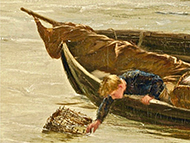
Viktor Vasnetsove, Flying Carpet (1919–1926, detail)
Flying
The Babbington Press (2020)
Paperback: 479 pages, $ 25.95
Hardcover: 479 pages, $ 29.95
Amazon Kindle: $5.99
Apple Books: $5.99
Flying
(a reading, nine minutes long)
Albertine Takes a Tumble
“The confines of the average garage,” I said to Albertine.
“Ahhh, darling,” she said with a sigh, “you know how I love that sweet talk.”
“The confines of the average garage,” I repeated seductively.
“Mmm,” she moaned with pleasure.
“Those confines come up again and again in the descriptions of these build-it-yourself planes.”
“All the romance has gone from garages, I see,” she said, pouting.
“The people selling the kits or plans are always reassuring the prospective builder that the plane can be built ‘within the confines of the average garage.’”
“And you suspect them of stretching the truth? Or shrinking the truth?”
“It’s not that. It’s the word that surprises me.”
“Garage?”
“No. Confines.”
“I prefer garage. If you say it right, it sounds like a term of endearment. ‘Oh, how I lahhhve you, my leettle garrr-azzzh.’”
We were having this conversation on the roadway that winds through Central Park, on a Sunday afternoon. The road is closed on weekends to vehicular traffic but available to runners, walkers, skaters, dogboarders, and bicycle riders. We were on our bicycles. It was a fine day in late fall, the air cool, the sun low but warming, our spirits light.
“It surprises me that they don’t just say, ‘You can build it in a garage.’”
“Well, Peter, I think they want to make the point that you can build it in the space that would be available in your garage if you have a garage, but that you don’t actually have to have a garage.”
“Yes, but—”
“Not everyone has a garage. We don’t.”
“We have no car.”
“Exactly. Therefore, no need for a garage. So the people selling the kits or plans may be trying to reassure the prospective builder that a garage is not actually required, just the space that your garage would contain if you had one.”
“The space contained by the average garage would easily fit within the confines of our apartment,” I pointed out.
She turned to deliver a rejoinder, and I saw the accident occur, the absurd events preceding it, the awful instant of coincidence, and the consequence.
To Albertine’s right, a woman was dogboarding, and to her left, another woman was dogboarding. In the space of the five years that Albertine and I had been living in Manhattan, the sport of dogboarding had come from nowhere to attain a status of considerable popularity. I have heard people attempt to explain its sudden rise with the theory that it suited the predilections of many because it was an outdoor activity in which the dog did the work rather than the master, that it required gear expensive enough to give it consumer snob appeal (particularly if you counted the dog), and that it offered a physical and sensual experience that other urban sports did not, combining as it did elements of wake riding, skateboarding, and snowboarding. In addition, though, I think we should not discount the powerful appeal of its giving residents of the Upper East Side something they seem to have craved for a long time: a reason for housing a large dog in the confines of a small apartment.
The dogboarder’s dog is outfitted with a harness similar in cut to the coats that pampered pets wear in cold weather. It fits over the dog’s chest and around its forelegs and back, with reins extending rearward from the sides. Behind the dog, the boarder stands on a platform that resembles a skateboard, with the difference that instead of skate wheels the dogboard has two large wheels, miniatures of the high-tech wheels with composite rims that are used in bicycle racing, one fore and one aft, of a diameter great enough that they rise above the surface of the board, set within slots in the board and turning on axles that run through mounts below it.
I remember wondering, when I glanced at the enormous and powerful dog pulling the woman on Albertine’s right, whether it had been bred expressly for dogboarding. The dog pulling the woman on Albertine’s left was smaller, but not by much, and it was especially keen. It strained in its harness in a way that the larger dog did not, lunging forward whenever the other moved a bit ahead. I wondered, and I intended to discuss this with Albertine later, after the women had passed by, whether they were longtime rivals, competitors in business and within their social set and now in the dogboarding arena of Central Park. In the manner of super-heroes, both were dressed in sleek, formfitting, iridescent outfits that advertised their fitness and firmness and enhanced the resplendence of their bodies in action. They were running a playful game, crisscrossing, playing their dogs as charioteers would their steeds, tugging lightly at their harnesses to yaw the dogs this way and that. Though neither allowed the other to remain ahead, the race they were running was not a race for position but for prominence in the eye of the beholder, status as the most adept and alluring dogboarder in the city. Their rivalry had infected their dogs; they snarled at each other across the couple of feet that separated them. Later, I told myself that I should have realized that the women and their dogs posed a threat to Albertine, but they were so fluent in their movements, the dogs so good at what they were doing and the women apparently so fully in control of their dogs, that they seemed to be harmless, until the moment when Albertine turned her head, just for an instant, to reply to me, and in that moment the smaller of the dogs did something to offend the larger. What? Nothing that I can see in my mind’s eye when I recall the moment. It may have been a look; it may have been something in his tone of voice, a vulgarity in his snarl; it may have been some grosser violation of the code of dogs; it may only have been that he strayed a bit from what the larger dog perceived as the proper confines of his lane. Whatever it was, it made the dog on the right respond suddenly and violently. He lunged at the dog on the left, to nip at his foreleg, I think, as a warning against persisting in that offensive behavior.
“Al!” I cried.
I saw the look on her face, saw that she was reading the look on my face. She saw the alarm there, and it made her swing around to face forward again. The dogboarding woman on the right tugged hard on the reins, but the dog was determined and resisted her. She yawed involuntarily, she fought to recover, she rolled, and her board shot from under her directly into Albertine’s path. Al saw it. In an instant of peripheral awareness she turned to the left to try to avoid it, but she was on top of it. Her front wheel struck the board, and Albertine pitched forward, up and over her handlebars and onto the pavement.
I was off my bike in a moment and at her side.
“Oh, my darling, my darling,” I said, kneeling beside her, kissing her, “my leettle garajzh.”
She didn’t seem to be in pain. She didn’t seem to be hurt, only surprised, but, “Something is wrong,” she said. “Something is wrong.”
|
|
|
|
|
|
|
|
|
|
|






Copyright © 2008 by Eric Kraft. All rights reserved. Photograph by Eric Kraft.
